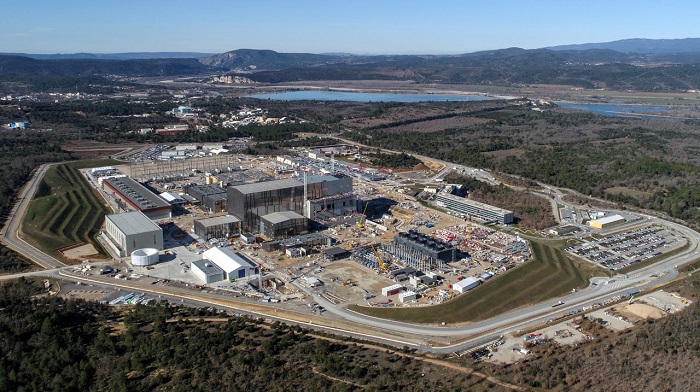Tokamak building ready to receive massive components

Aerial view of the Tokamak building and the Assembly Hall on the ITER site, Cadarche, France. The rooftop of the Tokamak building has been completed. The cranes of the Assembly Hall can now access the central pit so as to install heavy components. © EJF Riche, ITER Organization
The cranes of the Assembly Hall, the workshop where the gigantic components will be put together, can now access the main edifice of the project, the Tokamak building, to unload components weighing up to 1200 t. A rooftop is fully covering both buildings closing them permanently from above so that the pieces of equipment are safely installed in the central pit. We are now ready for the assembly phase of ITER—the most powerful fusion device in the history of mankind.
Europe, the host of the project, is responsible for the construction and civil engineering works of the 39 buildings and facilities. The 42 hectares of the platform – the land of the project to test the energy of the sun— have been fully transformed since 2010 when the first works began. Under the supervision of F4E, approximately 600 companies (counting main contractors and subcontractors) have been involved in the field of construction by giving their expertise and deploying resources to provide the necessary infrastructure. At times more than 1 000 workers in three shifts have been rotating, and together with a workforce of 700 engineers have contributed to the construction of the Tokamak complex which consists of the Tritium, Tokamak and Diagnostics buildings. It is calculated that the works performed amount to a total of six million hours.

The 60 m high Tokamak building, overtaking the Arc de Triomphe (France), will be the home of the ITER device. On each of its seven floors different pieces of equipment will be installed to operate the impressive fusion device. The weight of the ITER device is in the range of 23 000 t – roughly three times the load of the Eiffel Tower. The building complies with the strict standards of the French Nuclear Authority and is based on 30 000 drawings resulting from 1 000 000 hours carried out by the Engageconsortiumconsisting of Egis, Atkins, Assystem, Empresarios Agrupados. The Vinci, Ferrovial,Razel-Bec (VFR) consortium has been responsible for the construction of this complex. Various types of concrete were developed- it is estimated that up to 275 000 t were used- and approximately 26 500 t of steel and rebars.
The completion of this milestone is significant for several reasons. First, by opening the temporary wall between the Assembly Hall and the Tokamak building the heavy load cranes can access the pit where the ITER machine will be installed. This is a turning point in the history of the project because now the assembly phase and the installation of components in the pit can begin. ITER Organization and the ITER parties can now start planning together the next steps. Second, F4E and the companies involved have successfully concluded a major project milestone by finishing the works on time. “The good collaboration between F4E, our contractors and ITER Organization has been essential to work consistently as one team in the interest of the project. All parties showed a profound level of commitment, courage and resilience to respect the timeframe of this challenging milestone involving several stakeholders and companies,” explains Laurent Schmieder, F4E Programme Manager for Buildings, Infrastructure and Power Supplies (BIPS). “What started as a procurement strategy for the civil engineering works of the biggest fusion energy experiment has successfully delivered the buildings and necessary infrastructure for the next chapter of the ITER project, that of assembly.”
To view the history of this impressive milestone click here.